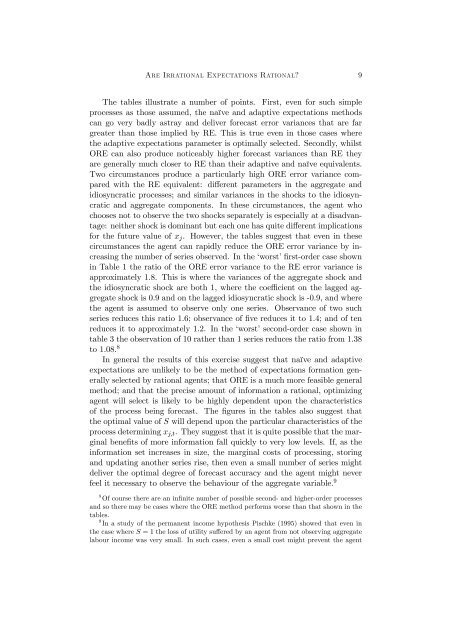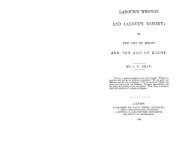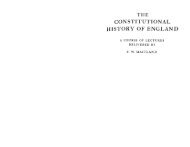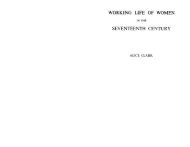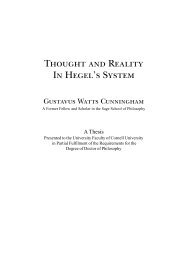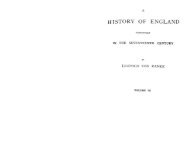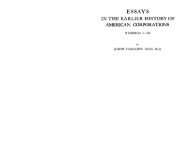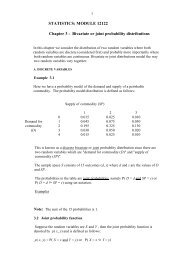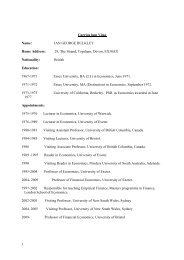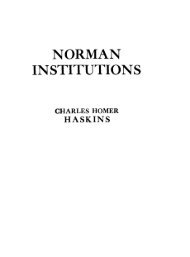are irrational expectations rational? David Demery Nigel W. Duck1 ...
are irrational expectations rational? David Demery Nigel W. Duck1 ...
are irrational expectations rational? David Demery Nigel W. Duck1 ...
You also want an ePaper? Increase the reach of your titles
YUMPU automatically turns print PDFs into web optimized ePapers that Google loves.
Are Ir<strong>rational</strong> Expectations Rational? 9The tables illustrate a number of points. First, even for such simpleprocesses as those assumed, the naïve and adaptive <strong>expectations</strong> methodscan go very badly astray and deliver forecast error variances that <strong>are</strong> fargreater than those implied by RE. This is true even in those cases wherethe adaptive <strong>expectations</strong> parameter is optimally selected. Secondly, whilstORE can also produce noticeably higher forecast variances than RE they<strong>are</strong> generally much closer to RE than their adaptive and naïve equivalents.Two circumstances produce a particularly high ORE error variance comp<strong>are</strong>dwith the RE equivalent: different parameters in the aggregate andidiosyncratic processes; and similar variances in the shocks to the idiosyncraticand aggregate components. In these circumstances, the agent whochooses not to observe the two shocks separately is especially at a disadvantage:neither shock is dominant but each one has quite different implicationsfor the future value of x j . However, the tables suggest that even in thesecircumstances the agent can rapidly reduce the ORE error variance by increasingthe number of series observed. In the ‘worst’ first-order case shownin Table 1 the ratio of the ORE error variance to the RE error variance isapproximately 1.8. This is where the variances of the aggregate shock andthe idiosyncratic shock <strong>are</strong> both 1, where the coefficient on the lagged aggregateshock is 0.9 and on the lagged idiosyncratic shock is -0.9, and wherethe agent is assumed to observe only one series. Observance of two suchseries reduces this ratio 1.6; observance of five reduces it to 1.4; and of tenreduces it to approximately 1.2. In the ‘worst’ second-order case shown intable 3 the observation of 10 rather than 1 series reduces the ratio from 1.38to 1.08. 8In general the results of this exercise suggest that naïve and adaptive<strong>expectations</strong> <strong>are</strong> unlikely to be the method of <strong>expectations</strong> formation generallyselected by <strong>rational</strong> agents; that ORE is a much more feasible generalmethod; and that the precise amount of information a <strong>rational</strong>, optimizingagent will select is likely to be highly dependent upon the characteristicsof the process being forecast. The figures in the tables also suggest thattheoptimalvalueofS will depend upon the particular characteristics of theprocess determining x j,t . They suggest that it is quite possible that the marginalbenefits of more information fall quickly to very low levels. If, as theinformation set increases in size, the marginal costs of processing, storingand updating another series rise, then even a small number of series mightdeliver the optimal degree of forecast accuracy and the agent might neverfeel it necessary to observe the behaviour of the aggregate variable. 98 Of course there <strong>are</strong> an infinite number of possible second- and higher-order processesand so there may be cases where the ORE method performs worse than that shown in thetables.9 In a study of the permanent income hypothesis Pischke (1995) showed that even inthecasewhereS =1the loss of utility suffered by an agent from not observing aggregatelabour income was very small. In such cases, even a small cost might prevent the agent


